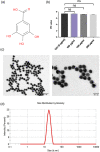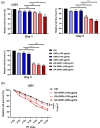Gallic acid-gold nanoparticles enhance radiation-induced cell death of human glioma U251 cells
- PMID: 33372372
- PMCID: PMC7898864
- DOI: 10.1002/iub.2436
Gallic acid-gold nanoparticles enhance radiation-induced cell death of human glioma U251 cells
Abstract
Glioblastoma multiforme (GBM) is among the most common adult brain tumors with invariably fatal character. Following the limited conventional therapies, almost all patients, however, presented with symptoms at the time of recurrence. It is dire to develop novel therapeutic strategies to improve the current treatment of GBM. Gallic acid is a well-established antioxidant, presenting a promising new selective anti-cancer drug, while gold nanoparticles (GNPs) can be developed as versatile nontoxic carriers for anti-cancer drug delivery. Here, we prepared gallic acid-GNPs (GA-GNPs) by loading gallic acid onto GNPs, reduction products of tetrachloroauric acid by sodium citrate, through physical and agitation adsorption. GA-GNPs, rather than GNPs alone, significantly inhibited the survival of U251 GBM cells, as well as enhanced radiation-induced cell death. Moreover, GA-GNPs plus radiation arrested the cell cycle of U251 at the S and G2/M phases and triggered apoptotic cell death, which is supported by increased BAX protein levels and decreased expression of BCL-2. Thus, GA-GNPs have great potential in the combination with radiation therapy in future studies for GBM treatment.
Keywords: gallic acid; glioma; gold nanoparticles; radiotherapy.
© 2020 The Authors. IUBMB Life published by Wiley Periodicals LLC on behalf of International Union of Biochemistry and Molecular Biology.
Figures




Similar articles
-
Gallic acid enhancement of gold nanoparticle anticancer activity in cervical cancer cells.Asian Pac J Cancer Prev. 2015;16(1):169-74. doi: 10.7314/apjcp.2015.16.1.169. Asian Pac J Cancer Prev. 2015. PMID: 25640346
-
Intranasal Delivery of Temozolomide-Conjugated Gold Nanoparticles Functionalized with Anti-EphA3 for Glioblastoma Targeting.Mol Pharm. 2021 Mar 1;18(3):915-927. doi: 10.1021/acs.molpharmaceut.0c00911. Epub 2021 Jan 8. Mol Pharm. 2021. PMID: 33417456
-
Gold Nanoparticles Enhance the Anticancer Activity of Gallic Acid against Cholangiocarcinoma Cell Lines.Asian Pac J Cancer Prev. 2015;16(16):7143-7. doi: 10.7314/apjcp.2015.16.16.7143. Asian Pac J Cancer Prev. 2015. PMID: 26514503
-
Gold Nanoparticles as Radiosensitizers in Cancer Radiotherapy.Int J Nanomedicine. 2020 Nov 24;15:9407-9430. doi: 10.2147/IJN.S272902. eCollection 2020. Int J Nanomedicine. 2020. PMID: 33262595 Free PMC article. Review.
-
Gold Nanoparticles in Radiotherapy and Recent Progress in Nanobrachytherapy.Adv Healthc Mater. 2018 Aug;7(16):e1701460. doi: 10.1002/adhm.201701460. Epub 2018 May 4. Adv Healthc Mater. 2018. PMID: 29726118 Review.
Cited by
-
Folic-Acid-Conjugated Poly (Lactic-Co-Glycolic Acid) Nanoparticles Loaded with Gallic Acid Induce Glioblastoma Cell Death by Reactive-Oxygen-Species-Induced Stress.Polymers (Basel). 2024 Jul 30;16(15):2161. doi: 10.3390/polym16152161. Polymers (Basel). 2024. PMID: 39125187 Free PMC article.
-
Chemotherapeutic nanoparticles for glioblastoma.Front Oncol. 2025 Aug 11;15:1641752. doi: 10.3389/fonc.2025.1641752. eCollection 2025. Front Oncol. 2025. PMID: 40860814 Free PMC article. Review.
-
Natural Guardians: Natural Compounds as Radioprotectors in Cancer Therapy.Int J Mol Sci. 2024 Jun 25;25(13):6937. doi: 10.3390/ijms25136937. Int J Mol Sci. 2024. PMID: 39000045 Free PMC article. Review.
-
The molecular mechanisms of ferroptosis and its role in glioma progression and treatment.Front Oncol. 2022 Aug 16;12:917537. doi: 10.3389/fonc.2022.917537. eCollection 2022. Front Oncol. 2022. PMID: 36091118 Free PMC article. Review.
-
Mitochondrial dysfunction and cell death induced by Toona sinensis leaf extracts through MEK/ERK signaling in glioblastoma cells.PLoS One. 2025 May 9;20(5):e0320849. doi: 10.1371/journal.pone.0320849. eCollection 2025. PLoS One. 2025. PMID: 40343958 Free PMC article.
References
-
- Stupp R, Hegi ME, Mason WP, et al. Effects of radiotherapy with concomitant and adjuvant temozolomide versus radiotherapy alone on survival in glioblastoma in a randomised phase III study: 5‐year analysis of the EORTC‐NCIC trial. Lancet Oncol. 2009;10(5):459–466. - PubMed
-
- Brandes AA, Tosoni A, Franceschi E, et al. Recurrence pattern after temozolomide concomitant with and adjuvant to radiotherapy in newly diagnosed patients with glioblastoma: Correlation with MGMT promoter methylation status. J Clin Oncol. 2009;27(8):1275–1279. - PubMed
-
- Galati G, O'Brien PJ. Potential toxicity of flavonoids and other dietary phenolics: Significance for their chemopreventive and anticancer properties. Free Radic Biol Med. 2004;37(3):287–303. - PubMed
-
- Verma S, Singh A, Mishra A. Gallic acid: Molecular rival of cancer. Environ Toxicol Pharmacol. 2013;35(3):473–485. - PubMed
-
- Rasool M, Malik A, Manan A, et al. Roles of natural compounds from medicinal plants in cancer treatment: Structure and mode of action at molecular level. Med Chem. 2015;11(7):618–628. - PubMed
Publication types
MeSH terms
Substances
LinkOut - more resources
Full Text Sources
Research Materials

